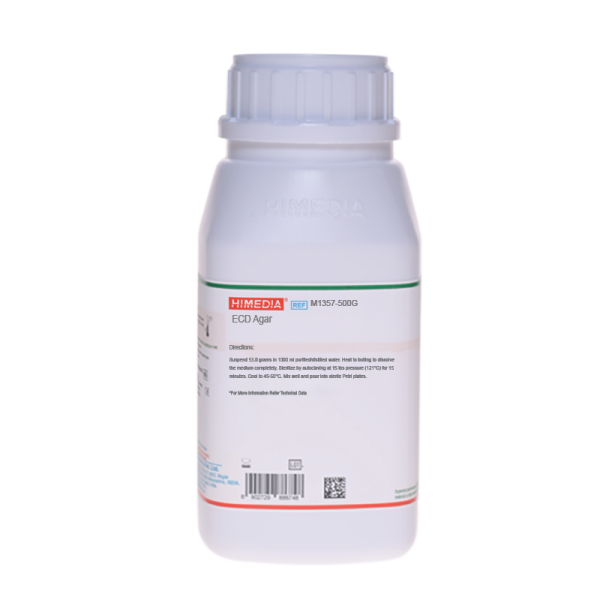 Your enquiry has been submitted
Your enquiry has been submitted
ECD Agar
Intended Use
Recommended for selective detection of coliforms, specially Escherichia coli in water, food and other material and in membrane filter technique.
Composition**
| Ingredients | Gms / Litre |
|---|---|
| Tryptone | 20.000 |
| Yeast extract | 5.000 |
| Bile salts | 1.500 |
| Sodium chloride | 5.000 |
| Disodium hydrogen phosphate | 5.000 |
| Potassium dihydrogen phosphate | 1.500 |
| Agar | 15.000 |
Final pH (at 25°C) 7.2±0.2
**Formula adjusted, standardized to suit performance parameters
Directions
Suspend 53.0 grams in 1000 ml purified / distilled water. Heat to boiling to dissolve the medium completely. Sterilize by autoclaving at 15 lbs pressure (121°C) for 15 minutes. Cool to 45-50° C. Mix well and pour into sterile Petri plates.
Principle And Interpretation
ECD Agar is used for detection of coliforms, especially, Escherichia coli in water, food and other samples using membrane filter technique (6).
The water sample is filtered through filter membranes, which are then placed on ECD Agar and incubated overnight. Lay a drop of Kovac's Indole Reagent (R008) on the colonies. Indole positive colonies form a red zone around the colony. Indole positive colonies are enumerated as E.coli.
The medium has tryptone and yeast extract which provide essential nutrients especially nitrogenous sources for the coliforms. Bile salts selectively inhibit gram-positive organisms. Sodium chloride maintains the osmotic balance while phosphate salts buffer the medium.
Type of specimen
Food and dairy samples; Water samples.
Specimen Collection and Handling
For food and dairy samples follow appropriate techniques for handling specimens as per established guidelines (1,5,7).
For water samples, follow appropriate techniques for sample collection, processing as per guidelines and local standards (2).
After use, contaminated materials must be sterilized by autoclaving before discarding.
Warning and Precautions
Read the label before opening the container. Wear protective gloves/protective clothing/eye protection/ face protection. Follow good microbiological lab practices while handling specimens and culture. Standard precautions as per established guidelines should be followed while handling specimens. Safety guidelines may be referred in individual safety data sheets.
Limitations
- Further biochemical and serological tests must be carried out for complete identification.
Performance and Evaluation
Performance of the medium is expected when used as per the direction on the label within the expiry period when stored at recommended temperature.
Quality Control
Appearance
Cream to yellow homogeneous free flowing powder
Gelling
Firm, comparable with 1.5% Agar gel
Colour and Clarity of prepared medium
Yellow coloured, clear to slightly opalescent gel forms in Petri plates
Reaction
Reaction of 5.3% w/v aqueous solution at 25°C. pH: 7.2±0.2
pH
7.00-7.40
Cultural Response
Cultural characteristics observed after an incubation at 35-37°C for 18-24 hours.
| Organism | Inoculum (CFU) | Growth | Recovery |
|---|---|---|---|
| Escherichia coli ATCC 25922 (00013*) | 50-100 | good-luxuriant | >=50% |
| # Klebsiella aerogenes ATCC 13048 (00175*) | 50-100 | good-luxuriant | >=50% |
| Salmonella Typhi ATCC 6539 | 50-100 | good-luxuriant | >=50% |
| Staphylococcus aureus subsp. aureus ATCC 25923 (00034*) | >=104 | inhibited | 0% |
Key: (*) Corresponding WDCM numbers, (#) Formerly known as Enterbacter aerogenes.
Storage and Shelf Life
Store between 10-30°C in a tightly closed container and the prepared medium at 20-30°C. Use before expiry date on the label. On opening, product should be properly stored dry, after tightly capping the bottle in order to prevent lump formation due to the hygroscopic nature of the product. Improper storage of the product may lead to lump formation. Store in dry ventilated area protected from extremes of temperature and sources of ignition Seal the container tightly after use. Product performance is best if used within stated expiry period.
Disposal
User must ensure safe disposal by autoclaving and/or incineration of used or unusable preparations of this product. Follow established laboratory procedures in disposing of infectious materials and material that comes into contact with sample must be decontaminated and disposed of in accordance with current laboratory techniques (3,4).
Reference
- American Public Health Association, Standard Methods for the Examination of Dairy Products, 1978, 14th Ed., Washington D.C.
- Baird R.B., Eaton A.D., and Rice E.W., (Eds.), 2015, Standard Methods for the Examination of Water and Wastewater, 23rd ed., APHA, Washington, D.C.
- Isenberg, H.D. Clinical Microbiology Procedures Handbook 2nd Edition.
- Jorgensen, J.H., Pfaller, M.A., Carroll, K.C., Funke, G., Landry, M.L., Richter, S.S and Warnock., D.W. (2015) Manual of Clinical Microbiology, 11th Edition. Vol. 1.
- Salfinger Y., and Tortorello M.L., 2015, Compendium of Methods for the Microbiological Examination of Foods, 5th Ed., American Public Health Association, Washington, D.C.
- Schweizerisches Lebensmittelbuch, 5th Ed., Chapter 56A.
- Wehr H. M. and Frank J. H., 2004, Standard Methods for the Microbiological Examination of Dairy Products, 17th Ed., APHA Inc., Washington, D.C.
| Product Name | ECD Agar |
|---|---|
| SKU | M1357 |
| Product Type | Regular |
| Physical Form | Powder |
| Origin | Animal |
| Packaging type | HDPE |
| References | 1. Schweizerisches Lebensmittelbuch, 5th Ed., Chapter 56A. |
| Customized Product Available | No |





